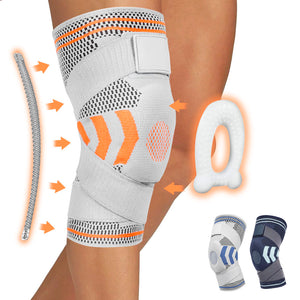What Causes Knee Arthritis?

Knee arthritis is a common condition that impacts people of all ages, but it is more prevalent in older persons. The structure of the knee joint and the ways that arthritis affects the various components of the knee are explained here. There is also useful guidance on treating and preventing knee arthritis. The article from Fivalifitness ends by advising readers to consult a doctor as soon as knee osteoarthritis symptoms appear to promote early diagnosis and efficient treatment.
Anatomy of the Knee Joint
The knee, one of the biggest and most intricate joints in the body, is supported in movement and stability by a network of interconnected bones, cartilage, muscles, tendons, ligaments, and other tissues. The main parts of the knee joint are as follows:
- Bone: The femur (thigh bone), tibia (lower leg bone), and patella (kneecap) make up your knee joint.
- Cartilage: The knee joint contains two different kinds of cartilage. The femur, tibia, and patella are covered in articular cartilage, which facilitates their smooth movement over one another. Situated amidst the thigh and calf bones, the meniscal cartilage serves as a cushioning agent.
- Muscles: The thigh and calf muscles link to the knee joint and supply the necessary movement force.
- Tendons: By joining the muscles to the bones, tendon connections allow the muscles to cooperate to move the knee joint.
- Ligaments: The femur and tibia are connected by the four primary ligaments, which also serve to support the knee joint and limit excessive motion and rotation. The medial collateral ligament (MCL) and lateral collateral ligament (LCL) run on either side of the joint, while the anterior cruciate ligament (ACL) and posterior cruciate ligament (PCL) cross each other within the joint.
- Synovium: The thin layer of tissue that envelops the knee joint and secretes the lubricating and nourishing synovial fluid.
The Types of Knee Arthritis
There are various forms of arthritis in the knee, but the two most prevalent ones are rheumatoid arthritis and osteoarthritis. An outline of these two categories is provided below:
- Osteoarthritis: As it develops as a result of the knee joint's cartilage gradually wearing down, this kind of arthritis is frequently referred to as "wear-and-tear" arthritis. As a result of the bones rubbing against one another due to cartilage degradation, discomfort, edema, and stiffness result.
- Rheumatoid arthritis: An autoimmune condition that causes inflammation of the joint linings, especially the knee, rheumatoid arthritis differs from osteoarthritis. Over time, the knee joint's cartilage and bones are harmed by this inflammation, which results in pain, swelling, and stiffness. Rheumatoid arthritis can strike anyone at any age, but it affects women more frequently than males.
- Other types of knee osteoarthritis: Includes juvenile idiopathic arthritis, which affects children under 16 years of age; post-traumatic arthritis, which occurs after a knee injury; and infectious arthritis, which occurs as a result of a bacterial, viral, or fungal infection in the joint.
Risk Factors
Many risk factors can raise an individual's chance of developing knee arthritis, such as:
- Age: The normal wear and tear on an individual's joints as they age leads to cartilage degradation, which raises the likelihood of developing knee arthritis.
- Gender: Women are more likely than men to get arthritis in their knees.
- Obesity: Weight gain puts an extra burden on the knees and increases the risk of arthritis.
- People who have suffered knee injuries, such as tears in the meniscus or ligaments, are more likely to get knee arthritis.
- Genetics: People may be predisposed to knee arthritis by specific genes.
- Occupational risks: There is a higher chance of knee injuries in jobs like farming or construction that need frequent knee bending or squatting.
Prevention and Treatment
Knee arthritis prevention and treatment involve a combination of lifestyle changes, pharmacological therapy, and other interventions. The following are some strategies for treating or avoiding knee arthritis:
- Keep a healthy weight: Being overweight increases the risk of arthritis by placing additional strain on the joints.
- Lead an active lifestyle: Frequent exercise can improve overall joint health and reduce the risk of injury by strengthening the muscles around the knee joint.
- Modify your actions: Running and leaping are examples of high-impact exercises that can strain your knees excessively. Think about low-impact activities like cycling or swimming.
- Protect the knee: You can lower your chance of suffering a knee injury by using a supportive knee brace during exercise or by wearing one when bending over or gardening.
- Medication: Acetaminophen and non-steroidal anti-inflammatory medicines (NSAIDs) are two over-the-counter pain relievers that can help manage knee osteoarthritis-related pain and inflammation. A healthcare provider may also suggest prescription drugs.
- Physical therapy: Seeing a physical therapist can help lower the risk of injury, manage symptoms, and increase the strength and flexibility of the muscles surrounding the knee.
- Injections: To help manage pain and inflammation, the physician may suggest hyaluronic acid or corticosteroid injections.
- Surgery: To replace the injured knee component in extreme cases when conservative treatment has failed, surgery may be advised.
Reference
Arthritis in Knee: Symptoms, Causes and Treatment
Knee arthritis symptoms and treatment - Everything You Need To Know - Dr. Nabil Ebraheim
*Disclaimer
The information provided in articles written by Fivali is intended for educational and reference purposes only. The content on this website (www.fivalifitness.com) is not intended to diagnose, treat, cure, or prevent any disease. We do not recommend self-diagnosis or self-treatment based on the information provided in our articles. Always consult a qualified healthcare professional if you have any concerns about your health or well-being.
If you are experiencing any symptoms or discomfort, we strongly encourage you to seek medical attention from a qualified healthcare professional. Only a licensed healthcare practitioner can provide an accurate diagnosis and an appropriate treatment plan tailored to your individual needs.
-
Posted in
Brace, Healthy Lifestyle, Pain, Recovery













